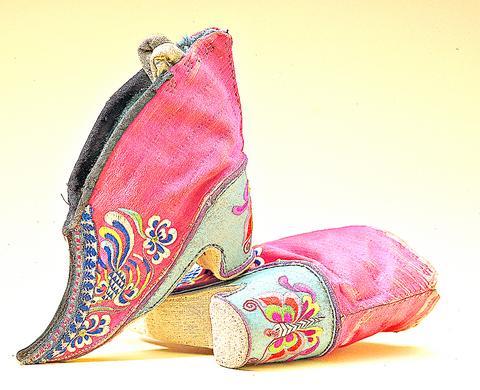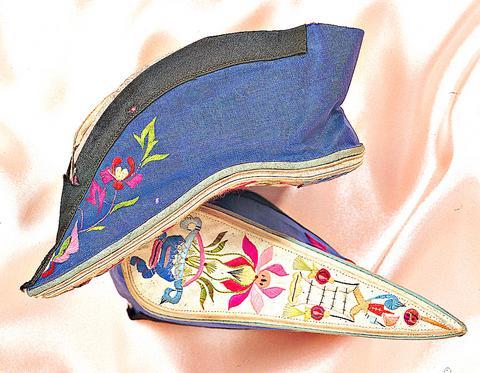The National Museum of History's (
The exhibition details the different shoe styles prevalent in different regions of China and Taiwan. All have in common delicate handiwork, beautiful patterns and bold color schemes. Some were clearly articles of high fashion in their days. The details of the embroidery reveal the social conditions of the region of origin. Some bow shoes from Taiwan have wooden heels, an influence of Japanese colonization.
Ke's X-ray photo of a bound foot hung next to one of a normal female foot helps viewers understand the physical aspect of the cultural practice. There are also detailed illustrations of how to bind feet correctly using a wide range of tools. If bound correctly, a woman's foot could fit into 5cm wide shoes, the smallest in the exhibition, which comes from southern Taiwan.

The origin of foot binding has not yet been pinned down, although most historical documents show the practice started during the Tang Dynasty. The trend took off in the Sung Dynasty, when a delicate physique was viewed as the basis for female beauty. In the Yuan Dynasty, bound feet were compared to a "golden lotus" and in Ming society they were an indication of high social class. Ching dynasty parents competed to have their sons marry women with the smallest possible feet.
Bound feet may seem a deformity today but for ancient Chinese it served many purposes. Apart from keeping woman in the home, a Confucian idea, people also believed that it improved a couple's sex life. As a woman with bound feet had to carry more weight with her hips and thighs, this was supposed to improve the function of her external sexual organs and enable her to give her husband greater sexual pleasure.
The transformation of women's lower body due to feet binding, Ke said, changed the sexual behavior of both sexes.

Ke bought his first pair of small shoes when he was 18. Over the last 28 years, he has collected 1,500 pairs of small shoes and 5,000, paraphernalia and historical documents, related to the practice. The director of a hospital in Taipei County, Ke has also published two books on bound feet.
He is currently working on a three-part trilogy on the artifacts, culture and sexual practices related to bound feet.
Ke's small shoes collection has toured in the US, Canada and Germany. Here his collection has been shown in many public galleries around Taiwan.
"A Thousand Years of Bound Feet" will run until Sept. 14 at the National Museum of History, 49 Nanhai Rd, Taipei (台北市南海路49號).

The canonical shot of an East Asian city is a night skyline studded with towering apartment and office buildings, bright with neon and plastic signage, a landscape of energy and modernity. Another classic image is the same city seen from above, in which identical apartment towers march across the city, spilling out over nearby geography, like stylized soldiers colonizing new territory in a board game. Densely populated dynamic conurbations of money, technological innovation and convenience, it is hard to see the cities of East Asia as what they truly are: necropolises. Why is this? The East Asian development model, with

June 16 to June 22 The following flyer appeared on the streets of Hsinchu on June 12, 1895: “Taipei has already fallen to the Japanese barbarians, who have brought great misery to our land and people. We heard that the Japanese occupiers will tax our gardens, our houses, our bodies, and even our chickens, dogs, cows and pigs. They wear their hair wild, carve their teeth, tattoo their foreheads, wear strange clothes and speak a strange language. How can we be ruled by such people?” Posted by civilian militia leader Wu Tang-hsing (吳湯興), it was a call to arms to retake

This is a deeply unsettling period in Taiwan. Uncertainties are everywhere while everyone waits for a small army of other shoes to drop on nearly every front. During challenging times, interesting political changes can happen, yet all three major political parties are beset with scandals, strife and self-inflicted wounds. As the ruling party, the Democratic Progressive Party (DPP) is held accountable for not only the challenges to the party, but also the nation. Taiwan is geopolitically and economically under threat. Domestically, the administration is under siege by the opposition-controlled legislature and growing discontent with what opponents characterize as arrogant, autocratic

When Lisa, 20, laces into her ultra-high heels for her shift at a strip club in Ukraine’s Kharkiv, she knows that aside from dancing, she will have to comfort traumatized soldiers. Since Russia’s 2022 invasion, exhausted troops are the main clientele of the Flash Dancers club in the center of the northeastern city, just 20 kilometers from Russian forces. For some customers, it provides an “escape” from the war, said Valerya Zavatska — a 25-year-old law graduate who runs the club with her mother, an ex-dancer. But many are not there just for the show. They “want to talk about what hurts,” she